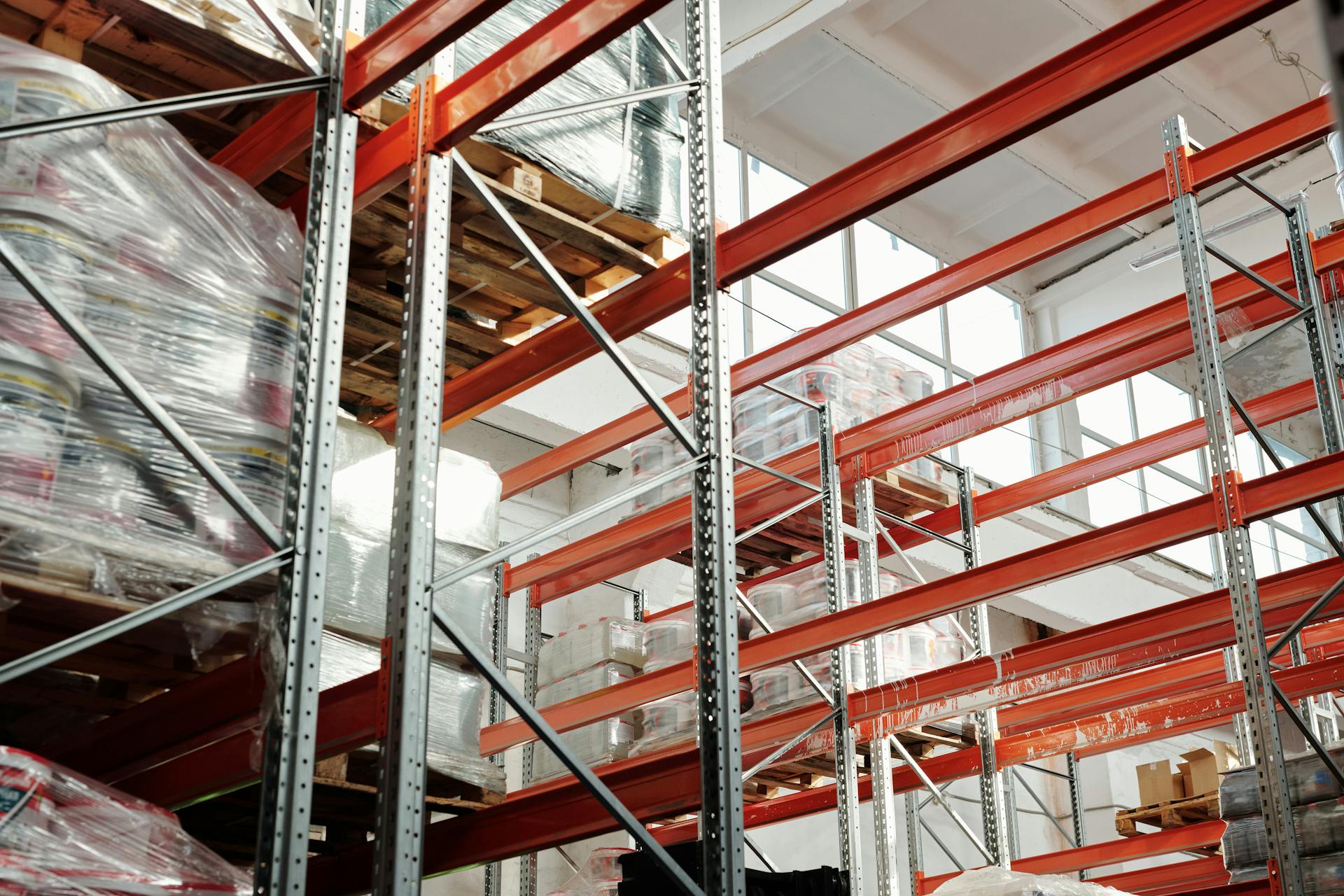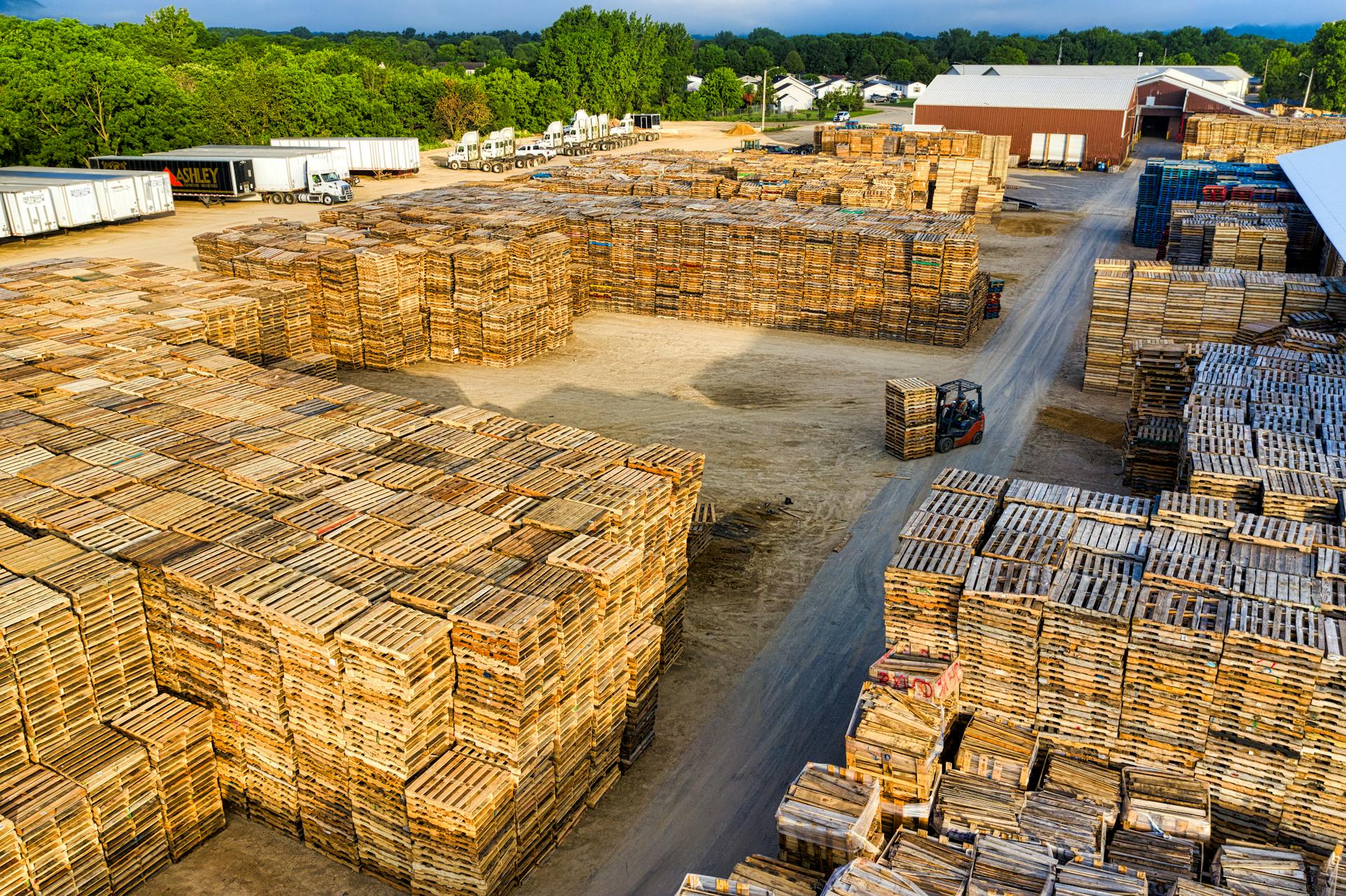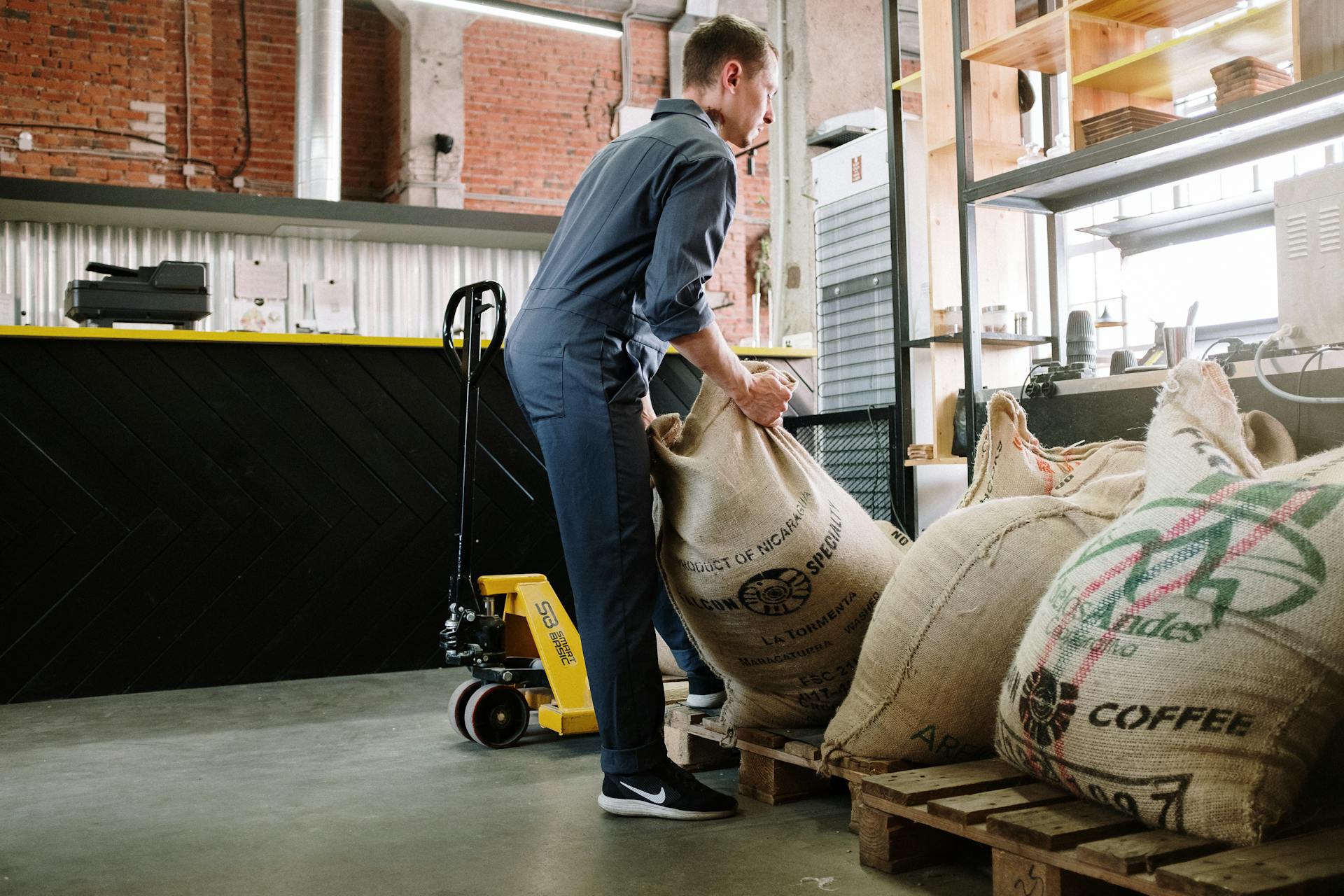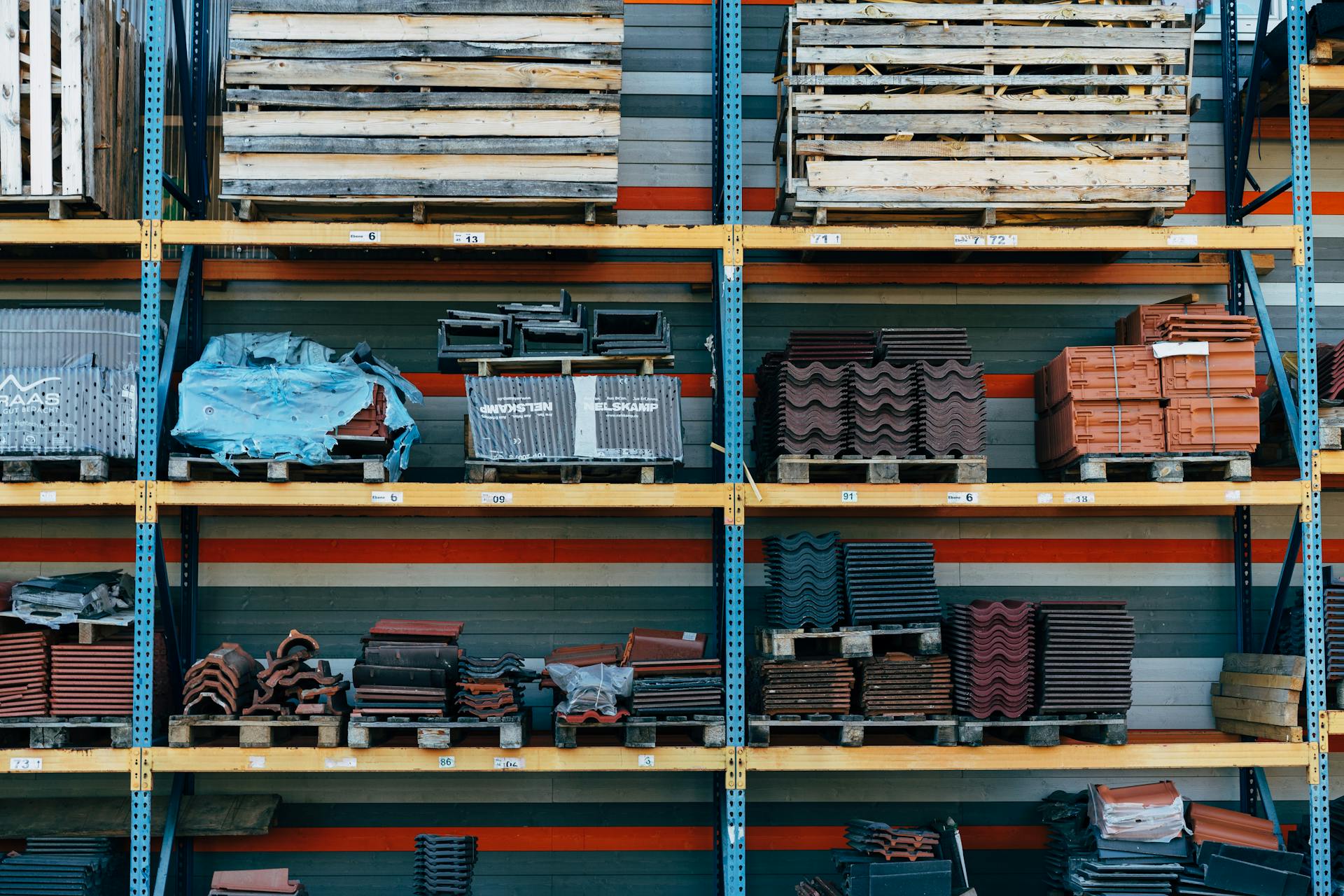
Stackable pallets are a game-changer for businesses and individuals alike. They allow for efficient storage and transportation of goods.
Stackable pallets come in various sizes, ranging from 24x24 inches to 48x48 inches, with different weight capacities to suit specific needs.
For example, a 40x48 inch pallet can hold up to 4,000 pounds of weight, making it perfect for heavy-duty applications.
The weight capacity of a pallet depends on its size, material, and design.
Readers also liked: Frac Tank Weight
Pallet Types
Let's take a closer look at the different types of pallets you can use for stackable storage. There are three main types of plastic pallets: rackable, stackable, and nestable.
Rackable plastic pallets are designed to be self-supporting and transfer weights to the rack beam and upright components, making them a great choice if you have a racking system.
Stackable plastic pallets are perfect for heavy loads stored low, and can also be used in a rack system with wire or solid decks that support the pallet's center section.
Additional reading: B Pallets

Nestable plastic pallets are ideal for applications that don't require extra heavy loads, and maximize empty pallet storage space, making them a great choice for facilities with limited storage space.
Here's a quick rundown of the three main types of plastic pallets and their uses:
By choosing the right pallet type for your specific needs, you can maximize your storage area and get the most out of your investment.
Pallet Features
Stackable pallets are incredibly versatile and come in a variety of features to suit different needs.
High-quality construction is a key feature of stackable pallets. They are crafted from rugged ACM or HDPE, providing consistent dimensions and impressive strength-to-weight ratios. This means they can withstand substantial dynamic and static loads, resist damage from transport and impacts, and endure temperatures ranging from -20˚ to 120˚ F.
You can choose from different runner options to ensure secure and uniform stacking and racking. The options include two, three, four, five, or six runners, depending on your specific needs.
Stackable pallets come with open and closed deck options. Open deck pallets are lightweight and well-suited to loads that need venting or drainage, while closed or solid deck options are perfect for heavy loads and industrial components in laboratories, meat processing plants, agriculture, manufacturing, and other cleanroom applications.
Some stackable pallets also offer optional metal reinforcements for increased durability when storing particularly heavy loads.
Here are some common features of stackable pallets:
- High-quality construction from ACM or HDPE
- Consistent dimensions and strength-to-weight ratios
- Substantial dynamic and static load capacity
- Resistance to damage from transport and impacts
- Temperature range: -20˚ to 120˚ F
- Runner options: 2, 3, 4, 5, or 6 runners
- Open and closed deck options
- Optional metal reinforcements for heavy loads
Pallet Racking Systems
If you're considering stackable pallets, it's worth noting that they can also be used in a rack system, provided you have wire or solid decks that support the pallet's center section.
Stackable pallets are a great option for heavy loads stored low, and they can provide a valuable long-term return on investment.
One of the benefits of stackable pallets is that they can maximize warehouse floor storage area, which is especially important if you have limited space.
In fact, a racking system can be an excellent solution for vertical storage problems, and it's safe and stable to boot.
If you're planning to use stackable pallets in a rack system, it's essential to choose the right type of pallet for the job. Here are some guidelines to keep in mind:
Ultimately, the right pallet type will depend on how you intend to use them, so it's a good idea to consult with a specialist before making a decision.
Stacking Methods
Floor stacking is the most economical pallet stacking approach, requiring nothing more than warehouse floor space.
This method allows you to stack pallets on top of each other, though it requires pallets specifically designed for stacking.
The main types of pallets are stackable, rackable, and nestable, each with specific design features that work with various uses and your space utilization will dictate your storage method.
Here are the benefits of stacking:
- Excellent solution for unlimited floor space applications
- Extremely stable for heavily loaded pallets
- Unlimited weight capacity including multiple pallet stacks
- Inexpensive costs with relatively low initial upfront investment
- No powered forklift or material handling machinery required for shorter stacks
- Good system for LIFO storage organization
Nestable
Nestable pallets are a great option for saving space in your warehouse or on transit trucks. They're designed to fit into each other when not holding loads, making them perfect for facilities with limited storage space.
Nestable pallets have hollow leg supports that allow lift truck tines to access the pallet surface, and they're typically lightweight due to their hollow design. However, this also means they have limited weight capacity and should be used carefully to avoid overloading.
A key feature of nestable pallets is their ability to nest or squeeze together, thanks to their unique profile. This design allows them to operate as normal product support platforms, just like rackable and stackable pallets.
Most nestable plastic pallets are designed to be used in specific applications, such as storing empty pallets between load times. If your facility and transport network stores many empty pallets, investing in a quality stock of nestable pallets can be a great way to save space.
Explore further: Right Space Storage Derry Nh
Here are some important things to keep in mind when using nestable pallets:
- Check the manufacturer's weight rating before loading your nestable pallets.
- Nestable pallets have no structural bridge capacity and can't be placed on racks unless there's a solid deck in place.
- They have limited crush resistance and should be used carefully to avoid damage.
- They can be set directly on the floor when fully loaded, but be careful about placing multiple stacks upon a nestable plastic pallet.
Empty
When not in use, stackable pallets can be neatly stacked and stored in a strategic location for future use.
Unused stackable pallets can take up valuable space in warehouses, but they can also be a valuable resource if stored properly.
You should always review and check the integrity and stability of both your pallets and loads before stacking them.
Stackable pallets are best utilized where they have complete support underneath them, such as on rack decks that transfer point loads to the beams.
If you're stacking pallets, make sure you know what your load or product is capable of handling, as well as the capacity of your pallets.
For example, if you have a 3-tier level of boxes on a stackable pallet and you want to place another pallet load on top, you need to consider the weight and density of the boxes and the pallet.
In this case, if a stackable pallet with a 1000 lbs load is placed on top of a 3-level layer of boxes that weigh 10 lbs each, the boxes may not handle the weight and could crush or topple.
For your interest: Stacking Pallets
Stacking Methods
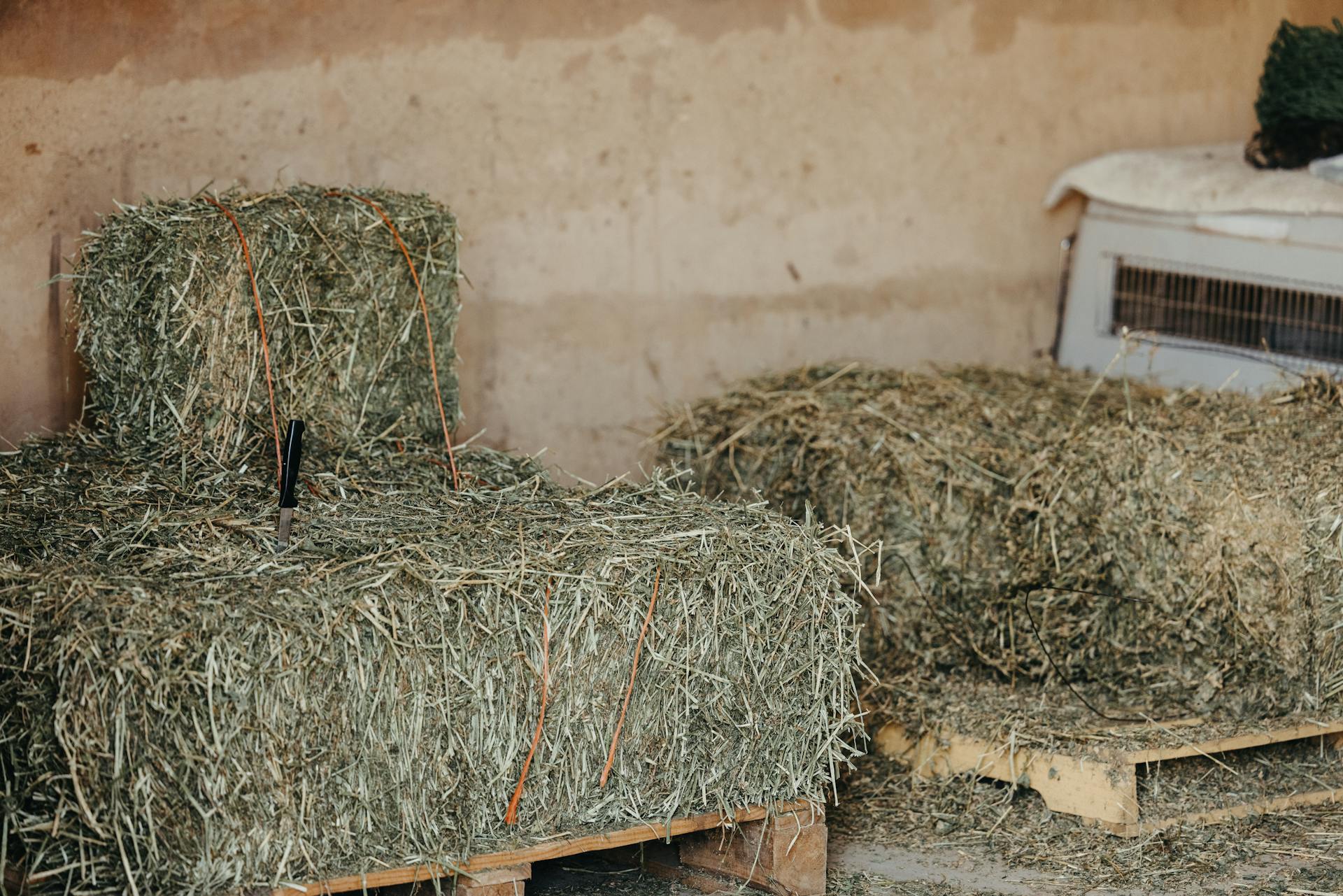
Floor stacking is the most economical pallet stacking approach, requiring nothing more than warehouse floor space.
To capitalize on floor space, you can stack pallets on top of each other, though this requires pallets specifically designed for stacking. These pallets are stackable, which means they can be placed on top of each other without collapsing.
Stackable pallets are excellent for unlimited floor space applications and can handle extremely heavy loads. They are also inexpensive, with relatively low initial upfront investment.
However, stackable pallets require proper support underneath them to prevent catastrophic failure. This is especially important when stacking multiple pallets on top of each other.
Here are some key benefits of stacking:
- Excellent solution for unlimited floor space applications
- Extremely stable for heavily loaded pallets
- Unlimited weight capacity including multiple pallet stacks
- Inexpensive costs with relatively low initial upfront investment
- No powered forklift or material handling machinery required for shorter stacks
- Good system for LIFO storage organization
It's essential to review and check the integrity and stability of both your pallets and loads before stacking them. This will ensure a safe and efficient storage solution.
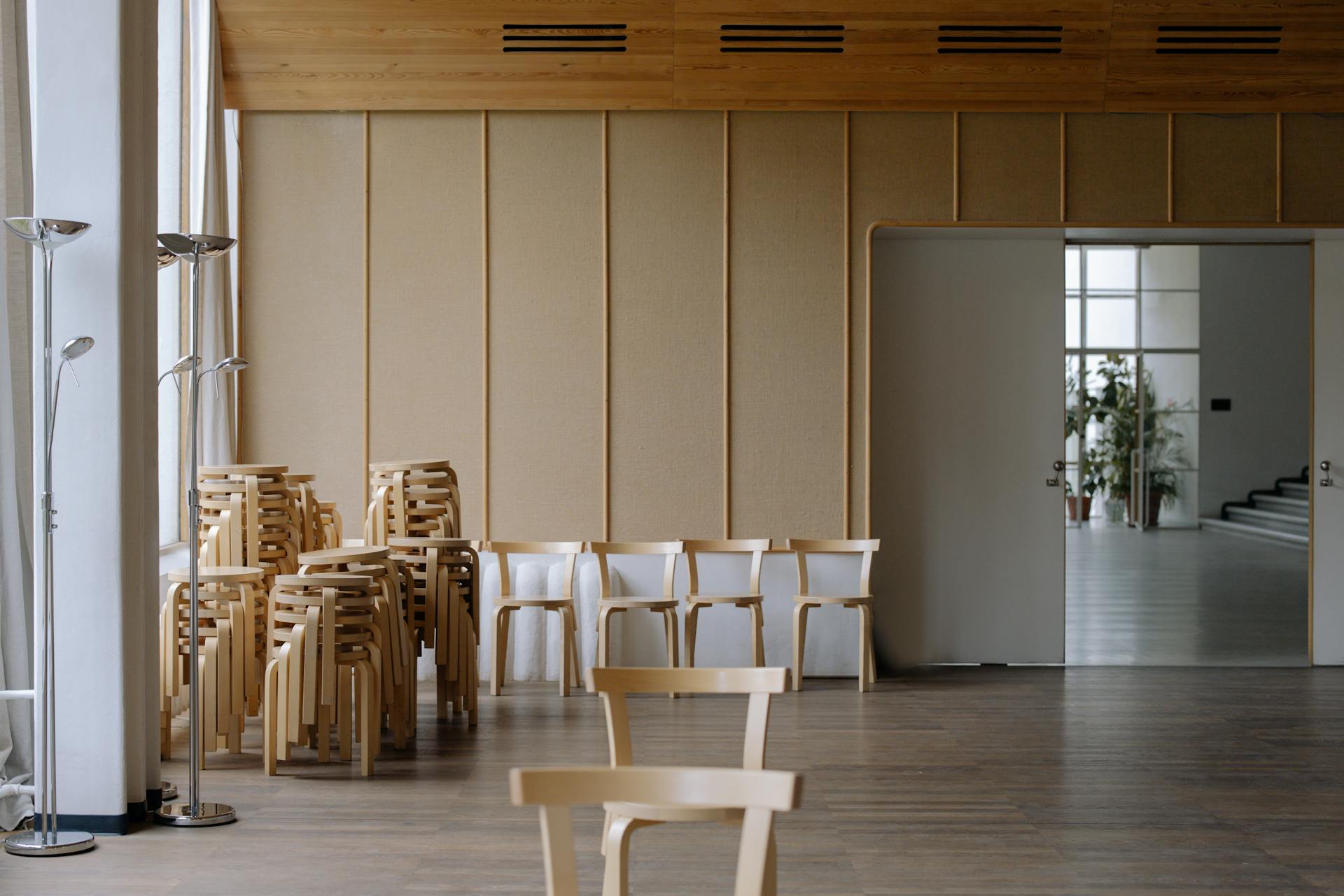
In contrast, racking systems provide a more efficient and space-saving option. By investing in quality pallet racks, you can maximize your warehouse area and save money in the long run.
Racking systems involve placing loaded pallets into a racking system composed of metal uprights, beams, and sometimes wire decking. This allows for easy access to pallets at any time and provides a safe and stable vertical storage system.
Here are some key benefits of racking:
- Excellent solution for vertical storage problems
- Safe and stable vertical storage system
- Maximizes warehouse floor storage area
- Valuable long-term return on investment
- Allows individual pallet access at all times
- Best application for FIFO storage concept
Benefits and Options
Stackable pallets are a game-changer for industries that require heavy-duty storage and transport solutions. One of the biggest advantages of stackable pallets is their cost-effectiveness, as they don't require a mold, making them less expensive to produce.
The design of stackable pallets also eliminates the need for additional tooling or fixture costs, thanks to robotic welding. This not only saves money but also streamlines the manufacturing process.
In terms of durability, stackable pallets are made from steel, which makes them resistant to cracking due to fatigue or heavy loads. This is a major advantage over plastic pallets, which can be prone to damage under heavy use.

Another benefit of stackable pallets is their ease of repair. If a pallet gets damaged, it can be easily repaired, extending its lifespan and reducing waste.
Here are some key benefits of stackable pallets:
- No mold required, making them less expensive
- No additional tooling or fixture costs
- Easily secured to a roll
- Easy handling due to gaps between strap surfaces
- Resistant to cracking due to fatigue or heavy loads
- Easily repaired
- Good scrap value at the end of its service life
- Easier to recycle
Delivery and Storage
When you're working with stackable pallets, delivery and storage are crucial considerations. The standard pallet size is 40x48 inches, making them easy to maneuver and store.
Stacking pallets high can be a space-saving solution, but be aware that a maximum of 5 pallets can be stacked safely.
A forklift or pallet jack can be used to transport and store pallets, reducing the need for manual labor.
Plastic
Plastic stackable pallets are a great option for businesses and industries that need to store and transport goods efficiently. They're designed to maintain maximum stability when stacked with or without products on them, especially during shipping.
These pallets are made from high-quality, one-piece polymer construction, which provides consistent dimensions and impressive strength-to-weight ratios. They can withstand substantial dynamic and static loads, resist damage from transport and impacts, and endure temperatures ranging from -20˚ to 120˚ F.

You can choose from various runner options, including two, three, four, five, or six runners, to ensure secure and uniform stacking and racking. This is especially useful when pallets are loaded or not.
Some plastic stackable pallets also come with open and closed deck options. Open deck pallets are lightweight and well-suited to loads that need venting or drainage, while closed or solid deck options are perfect for heavy loads and industrial components in laboratories, meat processing plants, agriculture, manufacturing, and other cleanroom applications.
If you're looking for added safety, consider our fire retardant and FDA approved models. And, as with all of our pallet types, One Way Solutions offers custom and specialty models of stackable pallets to meet the needs of any business or industry.
Here are some examples of plastic stackable pallets available:
Choosing the Right Pallet
If you're looking to maximize your storage area, choosing the right pallet is crucial. You'll want to consider the type of pallet that fits your specific needs.
Readers also liked: Which End of Pallet Industry Standard for Lifting Pallets Forklifts
There are three main types of plastic pallets: rackable, stackable, and nestable. Each has its own purpose and benefits.
Rackable plastic pallets are designed for use in racking systems, especially edge-racking systems. They're self-supporting and transfer weights to the rack beam and upright components.
Stackable plastic pallets are ideal for heavy loads stored low. They can also be used in a rack system with wire or solid decks that support the pallet's center section.
Nestable plastic pallets are perfect for applications where empty pallet storage space is a primary concern. They maximize space in your storage facility.
Here's a quick summary of the three types of pallets:
By choosing the right pallet for your needs, you'll be able to maximize your storage area and receive an excellent return on your investment.
Pallet Construction
Stackable pallets come in a variety of construction types, each with its own unique features and benefits.
Our stackable pallets are often made from high-quality, one-piece polymer construction, crafted from rugged ACM or HDPE. This ensures consistent dimensions and impressive strength-to-weight ratios.
On a similar theme: Construction Pallets
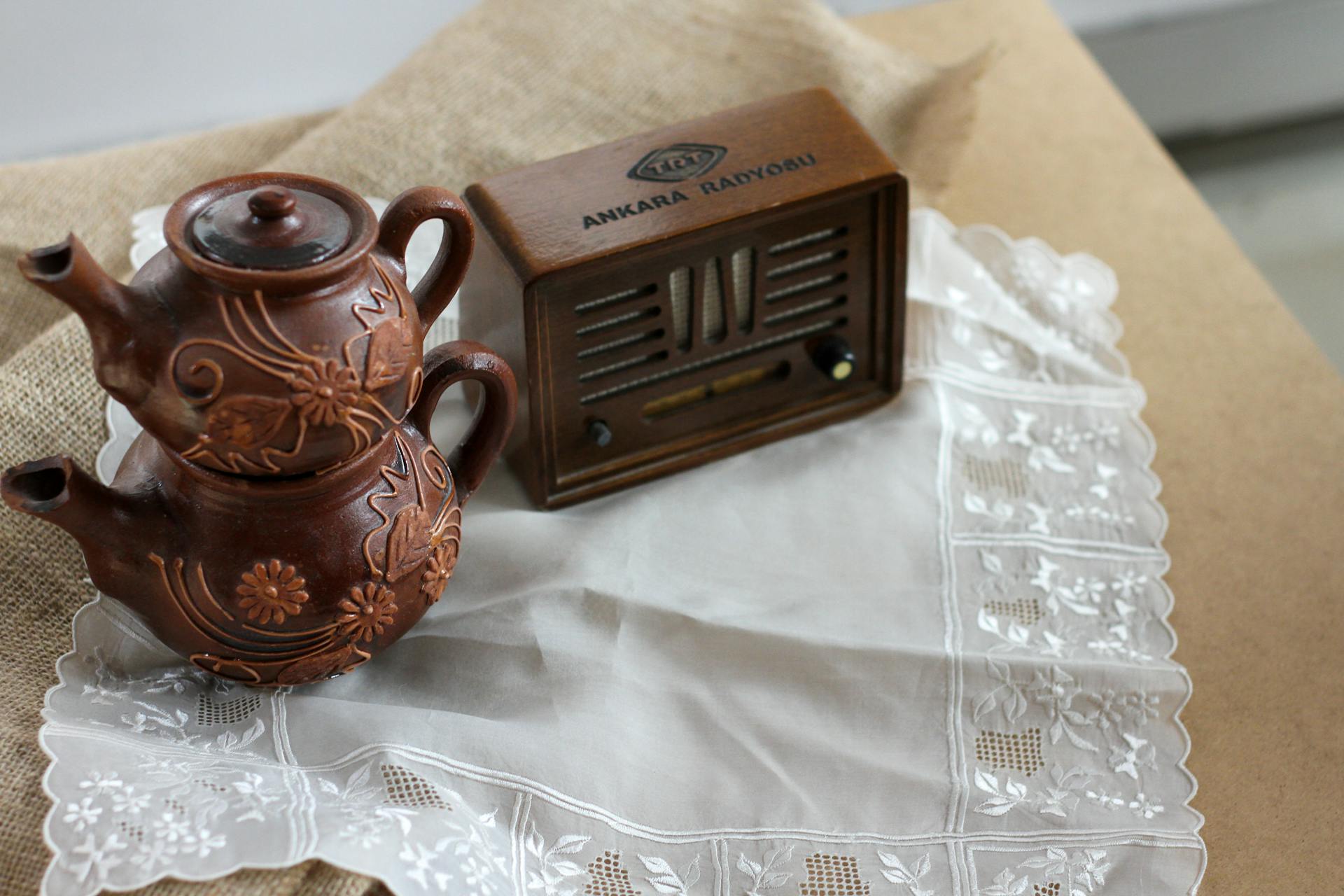
These pallets can withstand substantial dynamic and static loads, resist damage from transport and impacts, and endure temperatures ranging from -20˚ to 120˚ F.
Some stackable pallets also feature various runner options, including two, three, four, five, or six runners, to ensure secure and uniform stacking and racking.
Tab stackable pallets, on the other hand, are constructed out of welded steel and laser-cut components. These components are welded onto the cradle with the help of robotic centers.
For applications that require corner posts, SPS offers folding corners for stacking. Its underside consists of contact strap surfaces, which allow for strapping the rolled material to the cradle.
Here are some common types of stackable pallet constructions:
- High-quality, one-piece polymer construction
- Welded steel and laser-cut components (tab stack pallets)
- Open and closed deck options
- Optional metal reinforcements
Frequently Asked Questions
What is the OSHA rule for stacking pallets?
According to OSHA, pallets must be stacked in a stable and secure manner, with a focus on preventing sliding or falling hazards. Pallets should be blocked, interlocked, and limited in height to ensure stability.
What is the difference between stackable and non-stackable?
Stackable goods are booked by volume, while non-stackable goods are booked and charged by load meters. Non-stackable goods require special handling, such as fragile or irregularly shaped items.
Sources
- https://oneway-solutions.com/plastic-pallets/stackable-plastic-pallets
- https://reusabletranspack.com/product-category/48x40-stackable-plastic-pallets/
- https://blogs.material-handling.com/rackable-stackable-nestable-pallets/
- https://www.spsidealsolutions.com/products/tab-stack-pallets/
- https://www.tranpak.com/plastic-pallets/reusable/
Featured Images: pexels.com
